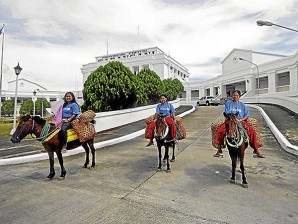
THE HORSEWOMEN OF ALABEL. Teachers stop for photo-ops on the driveway of the Sarangani Capitol before galloping to their villages on their horses donated by the United Nations Children’s Fund. COCOY SEXCION/CONTRIBUTOR
ALABEL, Sarangani, Philippines—The children of Barangay Kihan will now be able to learn their lessons straight from the horse’s back.
Mila Labuan and fellow tutors belonging to the group “supervised neighborhood play” (SNP), used to spend up to four hours each day hiking to reach the communities where they are assigned to teach basic education to children.
The neighborhood teaching program started months ago and Labuan and her group had had to endure long, rugged walks to reach Barangay Kihan in Malapitan town in this province. All they wanted was to be able to impart knowledge to the kids, who are mostly from the lumad communities.
On Monday, Labuan and 12 of her fellow workers assigned to hard-to-reach upland villages got a surprise with the turnover to them of 13 horses donated by the United Nations Children’s Fund (Unicef) to make their travels easier.
It was the Unicef’s second donation of horses for the Early Childhood Care and Development (ECCD) program of the province. In February, it turned over 10 ponies.
There are 110 SNP sites in far-flung barangays of the province and officials said they hoped to give most of the workers horses they could use to reach the communities.
Under the program, the education workers gather the children of each community in one place and teach them how to read and write—while allowing them also to play. The teaching sessions are aided by illustrated books, also donated by Unicef.
More time for teaching
With her horse, Labuan would now have more time for teaching, instead of spending a good part of it traveling. Many areas in the province are relatively rural and upland.
Racquel Panal, assistant provincial social welfare officer, said the use of horses should increase the participation of the children of Sarangani in the program, from 63 percent in 2010 to 70 percent this year.
“This would increase the number of children to be benefited, especially in remote communities, which are almost unreacheable by our service providers,” she said.
Lack of transportation
Panal said the lack of transportation in the remote villages had hampered the efforts of the SNP workers to teach.
In the past, instead of spending more time in the communities, the education workers would spend about half of the day walking just to reach their students, she said.
“With the ECCD on horses, they will now be able to deliver the best services to the children in the communities,” Panal said.